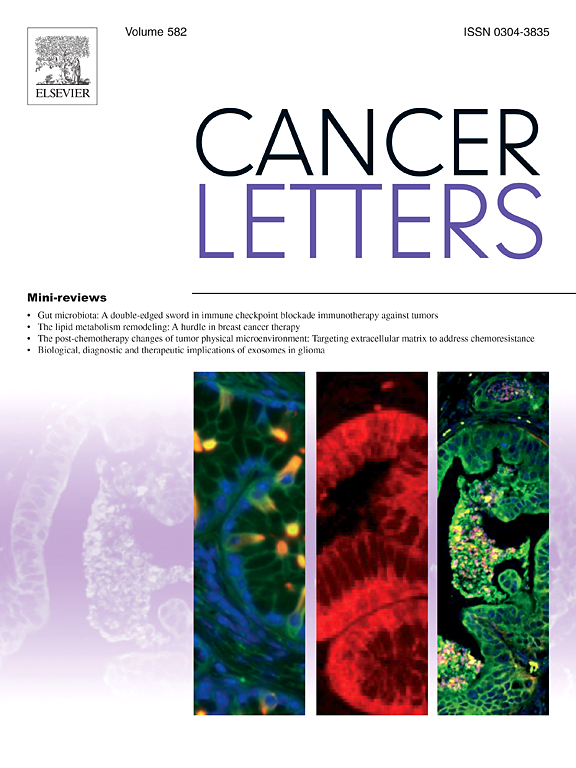Protein profile in urinary extracellular vesicles is a marker of malignancy and correlates with muscle invasiveness in urinary bladder cancer
IF 10.1
1区 医学
Q1 ONCOLOGY
引用次数: 0
Abstract
Urinary Bladder Cancer (UBC) ranks among the most prevalent cancers worldwide, has a high recurrence rate and unpredictable treatment responses. Thus, biomarkers are urgently needed. Extracellular vesicles (EVs) are released from both cancer- and immune cells and provide a snapshot of the originating cell. They are abundant in urine and are therefore candidate biomarkers for UBC.
Isolated urinary EVs from 39 UBC patients were compared with EVs from healthy controls, prostate cancer patients and whole urine. Samples were from bladder urine at time of both transurethral resection of the bladder tumour (TURB) and cystectomy, as well as urine taken from the ureter at cystectomy. EVs were isolated by tangential flow filtration and differential ultracentrifugation and their protein composition was detected by Proximity Extension Assay (PEA; Olink, immuno-oncology panel).
In UBC patients, the proteomic signature of bladder urine EVs differed from ureter urine EVs from the same individuals, and from bladder urine derived EVs of both healthy and prostate cancer controls. Pairwise comparison was performed with matched whole urine revealing proteins solely detected in isolated vesicles. Additionally, a distinct signature was identified in bladder urine EVs correlating with muscle invasiveness, and a trained classifier could predict UBC with 92 % accuracy. Some differentially expressed proteins, HO-1 and MMP7, were analysed by bead-based flow cytometry, where HO-1 was detected on the EV surface.
Taken together, these results strengthen the rationale of using EVs as non-invasive biomarkers and prognostic tools for UBC.
尿液细胞外囊泡中的蛋白质谱是恶性肿瘤的标志物,并与膀胱癌的肌肉侵袭性相关。
膀胱癌(UBC)是全球发病率最高的癌症之一,复发率高,治疗反应难以预测。因此,迫切需要生物标志物。癌细胞和免疫细胞都会释放胞外囊泡 (EV),EV 可提供起源细胞的快照。它们在尿液中含量丰富,因此是 UBC 的候选生物标记物。我们将 39 名 UBC 患者分离出的尿液 EV 与健康对照组、前列腺癌患者和全尿中的 EV 进行了比较。样本来自经尿道膀胱肿瘤切除术(TURB)和膀胱切除术时的膀胱尿液,以及膀胱切除术时从输尿管提取的尿液。通过切向流过滤和差速超速离心法分离出EV,并通过近距离延伸测定法(PEA;Olink,免疫肿瘤学面板)检测其蛋白质组成。在 UBC 患者中,膀胱尿液 EVs 的蛋白质组特征与同一人的输尿管尿液 EVs 不同,也与健康人和前列腺癌对照组的膀胱尿液衍生 EVs 不同。与匹配的全尿进行配对比较后发现,蛋白质只在分离的囊泡中被检测到。此外,在膀胱尿液 EVs 中还发现了与肌肉侵袭性相关的独特特征,训练有素的分类器预测 UBC 的准确率高达 92%。一些差异表达的蛋白质(HO-1 和 MMP7)通过基于微珠的流式细胞术进行了分析,其中 HO-1 在 EV 表面被检测到。综上所述,这些结果加强了将EV作为UBC的非侵入性生物标记物和预后工具的合理性。
本文章由计算机程序翻译,如有差异,请以英文原文为准。
求助全文
约1分钟内获得全文
求助全文
来源期刊

Cancer letters
医学-肿瘤学
CiteScore
17.70
自引率
2.10%
发文量
427
审稿时长
15 days
期刊介绍:
Cancer Letters is a reputable international journal that serves as a platform for significant and original contributions in cancer research. The journal welcomes both full-length articles and Mini Reviews in the wide-ranging field of basic and translational oncology. Furthermore, it frequently presents Special Issues that shed light on current and topical areas in cancer research.
Cancer Letters is highly interested in various fundamental aspects that can cater to a diverse readership. These areas include the molecular genetics and cell biology of cancer, radiation biology, molecular pathology, hormones and cancer, viral oncology, metastasis, and chemoprevention. The journal actively focuses on experimental therapeutics, particularly the advancement of targeted therapies for personalized cancer medicine, such as metronomic chemotherapy.
By publishing groundbreaking research and promoting advancements in cancer treatments, Cancer Letters aims to actively contribute to the fight against cancer and the improvement of patient outcomes.
 求助内容:
求助内容: 应助结果提醒方式:
应助结果提醒方式:


